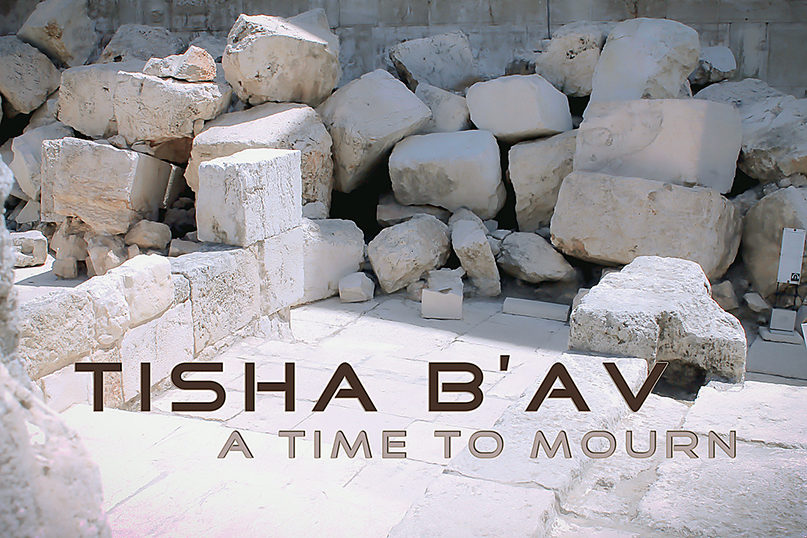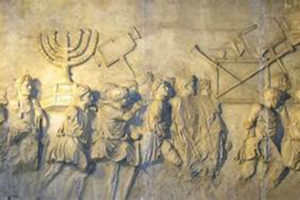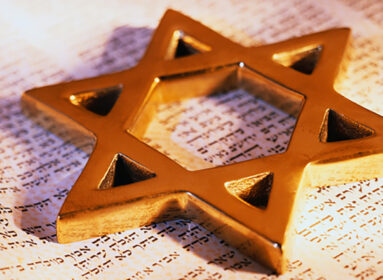
 Tisha B’Av begins at sundown on Saturday, August 10. However, since it is forbidden to fast on Shabbat (with the exception of Yom Kippur), the fast day is postponed until Sunday, August 11.
Tisha B’Av begins at sundown on Saturday, August 10. However, since it is forbidden to fast on Shabbat (with the exception of Yom Kippur), the fast day is postponed until Sunday, August 11.
Tisha B’Av – the ninth day of the Hebrew month of Av – is often considered the “saddest” day on the Jewish calendar. A fast day that commemorates the destruction of both the First and Second Temples, it is the culmination of a three-week period of increasing mourning that begins with the fast of the 17th of Tammuz, when the walls of Jerusalem were first breached, leading to the destruction of the First Temple.
While Tisha B’Av is primarily intended to recall the destruction of the Temples, both of which were destroyed on the ninth of Av, it is also considered a day to mourn the many other tragedies that have befallen the Jewish people on this day. Among them:
Spies return with evil reports from the land of Israel, leading the Jewish people to cry in despair and God to decree that the children of Israel wandering in the desert would not be permitted to enter the land of Israel.
The last fortress to hold out against the Romans during the Bar Kochba revolt falls, sealing the fate of the Jewish people. Over 100,000 Jews were killed.
The First Crusade is declared by Pope Urban II, bringing death and destruction to thousands of Jews, and obliterating many communities in Rhineland and France.
The Inquisition in Spain and Portugal culminates in the expulsion of the Jews from Spain in the year 1492. Tisha B’Av is set as the final date by which not a single Jew is allowed on Spanish soil.
Jews are expelled from England in the year 1515, accompanied by pogroms.
Deportations from Warsaw Ghetto to the Treblinka concentration camp begin in 1942.
Observing the day
Beyond the fast that begins at sundown, the day includes many of the same restrictions as Yom Kippur (which may be suspended for medical reasons.) Among them, one refrains from the following:
– Washing, bathing, shaving, wearing cosmetics. (Ritual washing is permitted.)
– Wearing new clothing or shoes, or clothing made of leather.
– Washing clothes or getting haircuts.
– Listening to music or engaging in other forms of entertainment.
– Sexual relations.
– Torah study (except for texts relevant to the day, such as the book of Eichah and Job.
It is customary to read the Book of Eichah – Lamentations – on Tisha B’Av, both at night and during the day: a series of deeply impassioned and poetic dirges in which the prophet Jeremiah implores the Jewish people to repent and describes in detail Jerusalem under siege and the utter destruction of the First Temple.
Tisha B’Av is the core of our independence
By Dror Eydar
(Israel Hayom via JNS) Historical memory is not a matter for annoying arguments about minutiae, it’s an issue of national security. We remember, therefore we are. “By the rivers of Babylon,” a Jewish exile wrote in Psalms after the destruction of the First Temple, “there we sat down and wept, when we remembered Zion” (Psalms 137:1).
Even then, our forefathers swore not to forget Jerusalem. This memory brought them back to Zion. And then, again, exile, and again, an oath. Where would we be if it weren’t for the memory of Zion and Jerusalem?
Today, Tisha B’Av is not a religious day in the narrow sense of the term. The destruction of the Second Temple wasn’t just the destruction of the Temple itself, but of our national homeland. Consider the history from the time of the Second Temple through today – into how many limbs the national body was split, to the number of countries to which we scattered, what persecution and rioting, suffering and distress we endured. And everywhere we thought we would be left in peace for a moment or for a century, we were served with a bill in blood and once again sent away into exile. The expulsion from Spain in the Hebrew month of Av in 1492 was the model for all the banishments. We rattled around a long exile that ended in the most terrible event in human history: the Holocaust. These disasters are all rooted in this day, on which for thousands of years we loaded all our mourning and tears, all the evil and destruction we experienced – personal, as well as national.
There can be no independence without the memory of Tisha B’Av. The nation cannot correct its path without acknowledging the events that led to the terrible destruction, the war between brothers, the different factions in Jerusalem in the seventh decade C.E. Brothers were turning on each other years before the bitter enemy arrived to finish the job.
There was a reason why our sages added two years to the actual date on which the Temple was destroyed (70 C.E.), bringing the social and political destruction forward to 68 C.E. This helps us understand the sages’ legend about Nebuzaradan, commander of Nebuchadnezzar’s guard (for various reasons, they were apparently referring to Titus and Rome): “It is a slain nation that you slew; it is a burned sanctuary that you burned; it is ground flour that you ground” (Eichah Rabbah 1:43). They taught us that the war between brothers was the main disaster, and the burning of the Temple was just a realization of it, an expression of the internal conflagration that was eating away and the hearts of the people and caused us to lose our independence – a lesson for the generations to come, especially our own.
Here is the testimony of Yosef Ben Matityahu (Josephus Flavius) about the destruction of the Temple from his book The Wars of the Jews. After he describes the horrible slaughter of Jews by the Romans:
“Nor was there a commiseration of any age, or any reverence of gravity; but children, and old men, and profane persons, and priests, were all slain” – the writer adds, “The flame was also carried a long way, and made an echo, together with the groans of those that were slain; and because this hill was high, and the works at the Temple were very great, one would have thought that the whole city had been on fire. Nor can one imagine anything either greater or more terrible than this noise; for there was at once a shout of the Roman legions, who were marching all together. … The people also that were left above were beaten back upon the enemy, and under a great consternation, and made sad moans at the calamity they were under; the multitude also that was in the city joined in this outcry with those that were upon the hill. The sound of the shouts of the people on the Mount joined the screams of the masses in the city as they saw the fire in the Temple. … One would have thought that the hill itself, on which the Temple stood, was seething hot, as full of fire on every part of it, that the blood was larger in quantity than the fire, and those that were slain more in number that those that slew them.”
Zion, we have not forgotten. Even after returning home from the four corners of the earth, we will continue to mourn, remember, and remind others what befell us. In memory lies the secret of redemption.
“As a mother comforts her child, so will I comfort you; and you will be comforted over Jerusalem” (Isaiah 66:13).








 Southern New England Jewish Ledger
Southern New England Jewish Ledger










